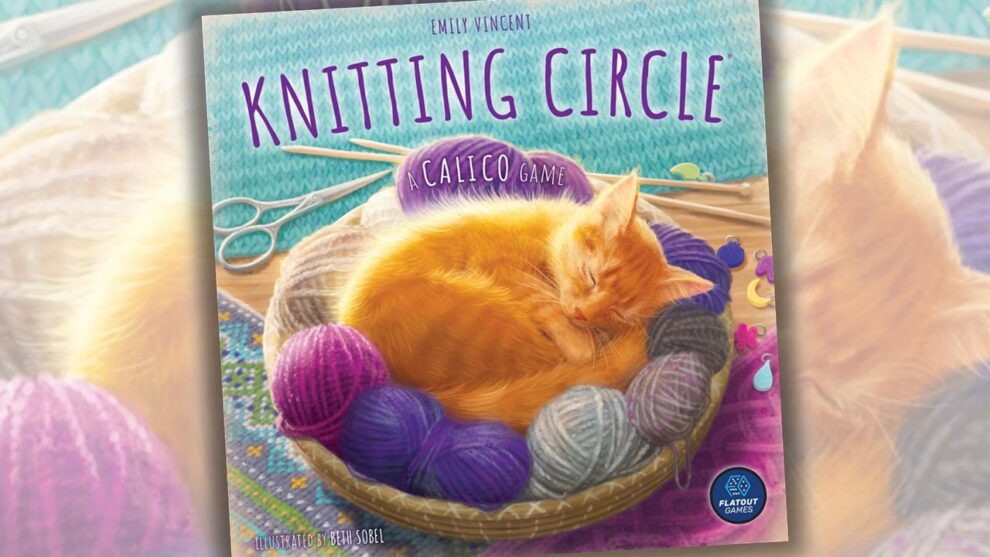Disclosure: Meeple Mountain received a free copy of this product in exchange for an honest, unbiased review. This review is not intended to be an endorsement.
It shouldn’t be any surprise that when a new Flatout Games title is announced, my heart skips a beat…two beats if animals are involved. So imagine my delight when I heard about Knitting Circle, a successor to 2020’s Calico, a wonderfully cozy game about cats and quilts. There aren’t any quilts in this game, but you will find hats, scarves, mittens, socks, sweaters, and long johns (flap not included). And more importantly, you’ll find cats, vivid colors, and that clever, puzzly-spatial gameplay that Flatout Games excels at.
So let me introduce you to Knitting Circle.
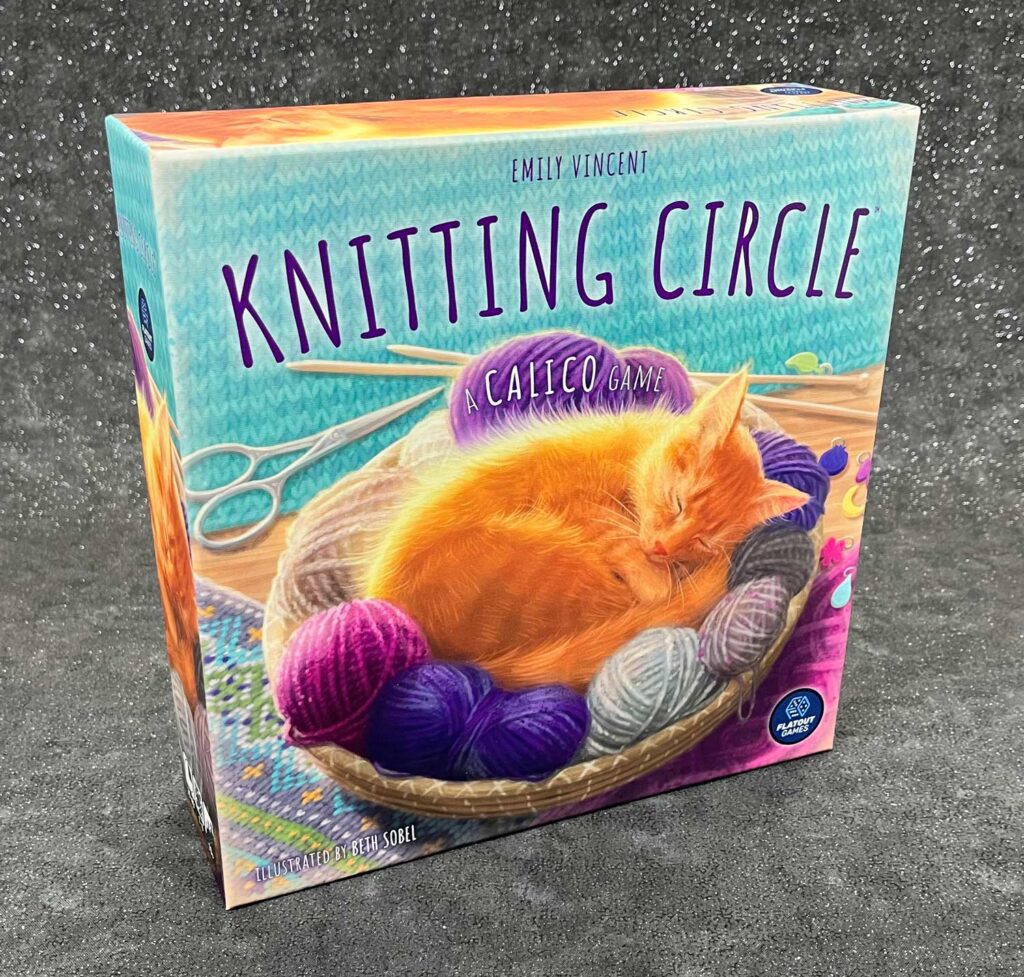
Knitting Circle Overview
In Knitting Circle, your goal is to earn the most points by creating completed clothing: combining garment cards, yarn tiles, and scoring buttons into a finished product. But it’s not as easy as it might sound. Make sure your garment meets one of the approved patterns or else you’ll earn the dreaded “ugly sweater” pin and lose points at the end of the game. Mix in the Advanced Request cards and your eyes will be seeing rainbows for hours after you finish each game.

Let’s briefly touch on setup, and then jump straight to the gameplay. Just be aware that each player starts with a player board, 2 yarn tiles for their bowl, 2 circle shaped color buttons, 2 triangle shaped pattern buttons, 2 square shaped garment buttons, 1 garment card of their choice, and an adorable “grabby paw” which I’ll cover in a bit. Additionally, the shared center area will feature a rondel where players will select yarn, along with 6 stacks of face down garment cards of varying lengths.

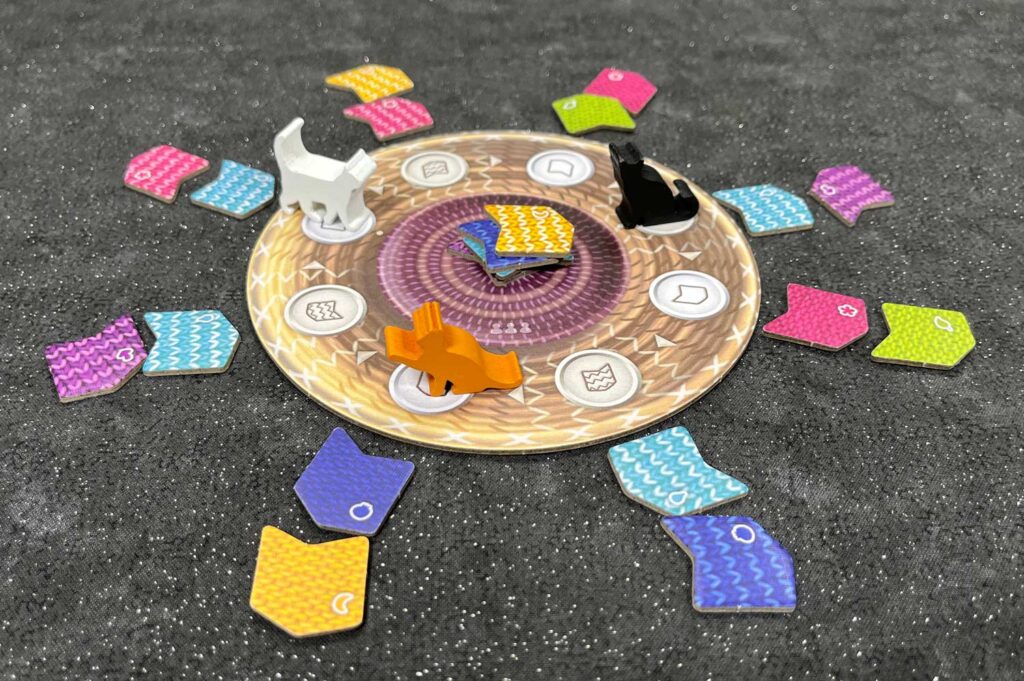
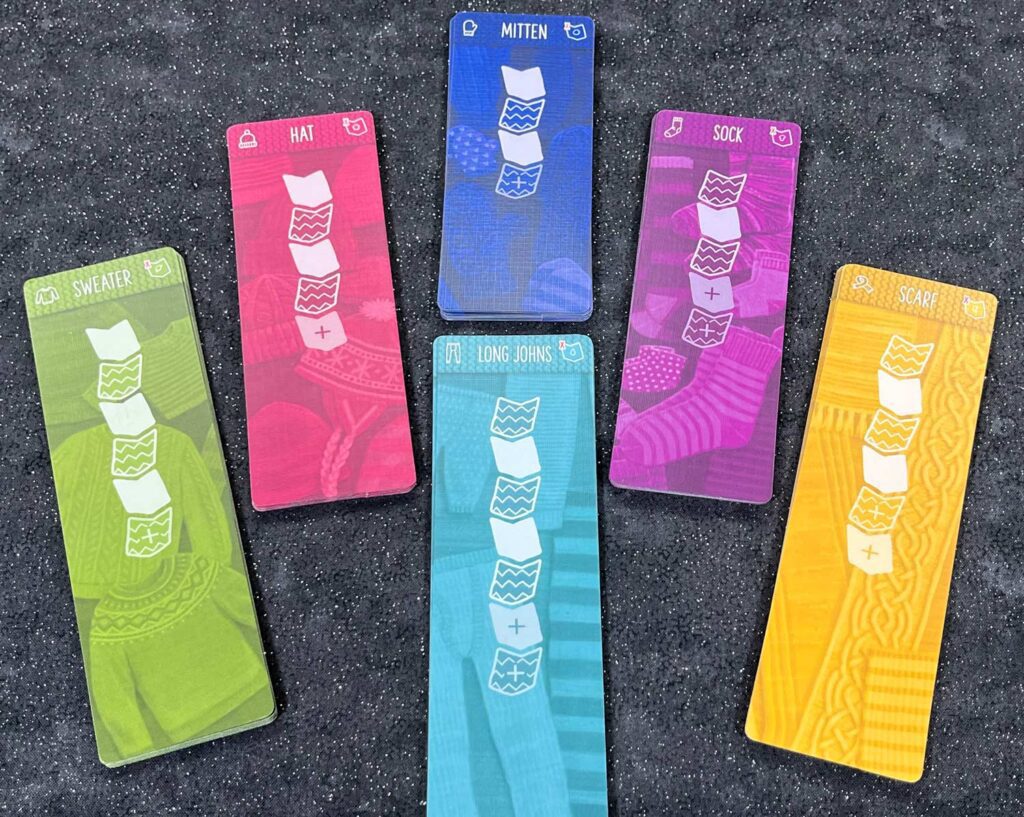
A Round of Knitting Circle
A round of Knitting Circle is broken into two phases
The Drafting Phase
In this phase, you’ll move your cat helper around the rondel (1 or 2 spaces at a time) to acquire yarn tiles for your player board. Pay attention to the circle and triangle buttons, as those will help guide your selections based on color and the desired pattern. Yarn tiles are double sided (the knit side and the purl side) and it makes a difference which side you pick up. You’ll notice that each garment card alternates between knit and purl, and once you take that yellow knit tile it must stay on your player board and be used in that orientation.
This means that not only do you have to focus on which colors to pick up, but you also have to make sure the tile is on the correct side, all while dodging and weaving around the cat helpers of other players. Like in many other games, Knitting Circle does not allow two pieces to occupy the same space.
“Zack, why’d you have to move to that space, I needed it!”
The Action Phase
After each player has 4 yarn tiles, it’s time to get busy. The Action phase is played simultaneously, and each player can perform as many of the actions as they like, in whichever order most benefits them.
The Knit action allows players to take any of their yarn tokens and place them on an active garment (indicated by the knitting token at the top of the card). The only rule is that the orientation of the tile (knit or purl) must match that of the space on the card. Remember that yarn tiles in your bowl are wild sided, which means you can play them for either side, as you need them. Yarn tiles acquired during the Drafting phase must remain on the side you selected them—unless you use the Flip action.
As you place yarn tiles on garment cards, you might cover a bonus spot, which grants you the bonus immediately.
The Flip action allows you to spend one yarn tile to flip over another yarn tile to its opposite orientation. Great, if you absolutely need a specific side, but not so great because yarn tiles are tight!
The Start Garment action allows you to pay one yarn tile for a garment card matching that yarn’s color. Draw two cards and keep whichever one you prefer. Pay attention to your current set of buttons in order to make the most out of your garment cards.
The Grab action allows you to spend a grabby paw to reach into the yarn bag and select exactly the color and side you need—but spend them wisely! You can even spend them to acquire a tile that will allow you to select a specific garment.
And finally, the Complete Garment action allows you to mark a garment card as finished, and add buttons to it. Each card can have up to 3 buttons, but no more than 1 button of each shape. Circle buttons will feature between 1 and 3 colors, and the completed garment must have all displayed colors. The triangle button shows 1 of 4 different patterns (stripes, color blocks, symmetrical, or solid) and the garment must match one of those in order to receive a triangle button. Finally, the square button can be added to a garment which matches that type.

Note that garment cards can be “completed” in two main ways: partially, by adding enough yarn tiles to meet the topmost number on the left side of the card (as in the center card above), or finished, by filling up the entire card.
Additionally, some garment cards offer an immediate bonus when completing them, while others offer end game scoring options.
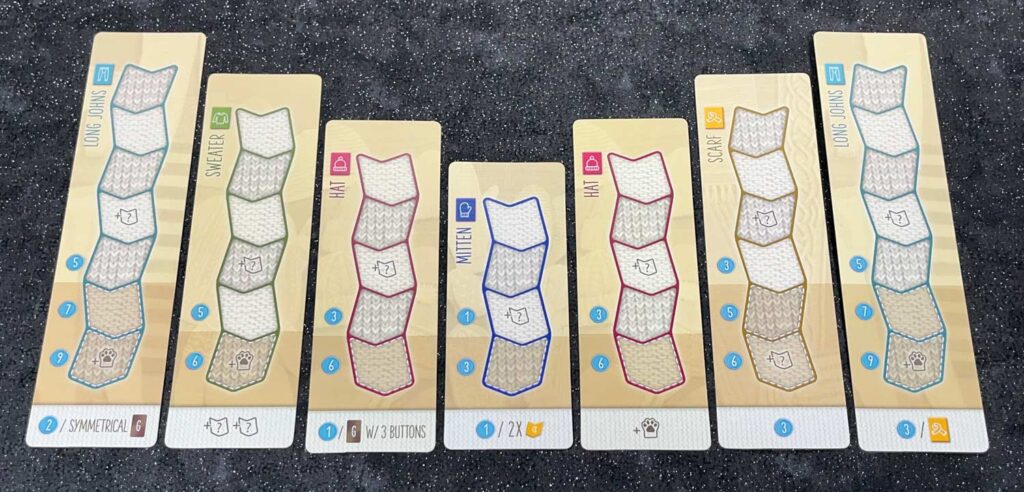
Game End and Scoring
The game ends at the end of the 6th Action phase, at which time players tally up their scores. Addup points for buttons, followed by points for the highest scored number on each garment card, then the end game scoring on any of your garment cards. Subtract ugly garment pins, and finally add in the Advanced bonus points (if you played with those) and the winner is the crafter with the highest score!
“Knitters use knitting to value-add to the world.”
That’s a quote from Stephanie Pearl-McPhee, a well-known knitter and author. While I admit that I had to look her up, I love the quote. There aren’t many hobbies that allow you to make something useful and interesting from something so humble. In fact, I’d say board game design might be another: taking scraps of paper, and an idea, to make something so enjoyable. And that’s what designer Emily Vincent has done with Knitting Circle. She took the framework of Calico and grafted onto it her love of knitting, and it just works.
There are loads of references to the original game: the colors are the same, as are the icons on the buttons, the cats—and of course the crafting theme. But more importantly, so is the puzzly nature of the game. This is a trait that Flatout Games both enables and nurtures and it shines through in every aspect of Knitting Circle, even before the game starts. Players must choose a garment card to begin the game with, but they only have their starting yarn tiles and buttons to guide them. You’ll likely want to complete a garment card as soon as possible in order to gain access to bonus tiles or, if you’re lucky, another grabby paw (they’re crucially important). But you also need to set yourself up for starting future garment cards. Assuming you don’t pick up any bonus yarn tiles, you’re only getting 26 of them over the course of 6 rounds, and even the smallest garment (the mittens) require 4, while the largest (the long johns) require a whopping 7 to complete.
Adding to the placement puzzle is the need to weave your cat token in and around the tokens of other players. Sometimes you have to settle for a less than ideal yarn tile with the thought that you can spend that to pick up another garment card or allow you to flip a different yarn tile, It’ss agonizing having the “right color tiles” but on the wrong sides, so being willing to spend a single tile could let you complete a garment card and get you a bonus.
And if that weren’t enough, the Advanced Request cards take things to another level entirely. In the last game I played, there was a card which required you to knit two mittens with identical stripe patterns (color and position), another which required you to have two sweaters with the same color block pattern, and yet another (the easy one) which required you to have 4 garments with the same color on them. Some of these cards require you to commit to a direction early or there’s no way you’ll complete them.
If you have time to knit it means you’re not worried about the essential stuff.
This is yet another quote from Stephanie Pearl-McPhee, and one that really rings true for Knitting Circle. Sure, there’s a lot of thinking in the game, but in the end it’s still a cozy and relaxing game about cats and yarn. This would be perfect for people who love cats, or crafting, or both. And if you value family time, sitting around the table with a board game, then a copy of Knitting Circle might just be in your future.


